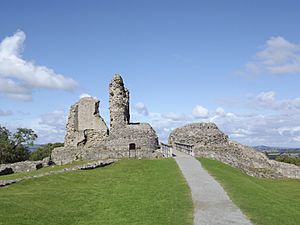Montgomery Castle facts for kids
Montgomery Castle (Castell Trefaldwyn in Welsh) is an old stone castle in Powys, Mid Wales. It stands high above the town of Montgomery. This castle was one of many Norman castles built along the border between Wales and England. These castles were very important for controlling the land.
The castle was in a key spot in the Welsh Marches. This meant it was often destroyed and rebuilt. This happened many times until the early 1300s. By then, the area became much more peaceful. During the First English Civil War, a big battle happened here on September 17, 1644. It was the largest battle in Wales during that war. After the Second English Civil War in 1649, the castle walls were pulled down. This was done to stop anyone from using the castle for fighting again.
Contents
The First Castle: Hen Domen
The very first castle here was a motte and bailey castle. It is now known as Hen Domen. Roger de Montgomery, who was the Earl of Shrewsbury, ordered it to be built. This happened sometime between 1071 and 1074.
Later, in 1102, Roger's son rebelled. The castle was then given to Baldwin de Boulers. This is where the Welsh name for Montgomery, "Trefaldwyn," comes from. It means "Baldwin's town." The de Boulers family held the castle until 1215. Then, Prince Llywelyn ab Iorwerth destroyed it. The old motte and bailey castle was later used as an outpost for the new stone castle. It probably lasted until about 1300.
Building the Stone Castle
The building of the new stone Montgomery Castle began in 1223. This was on the 16th birthday of Henry III of England. It was built about a mile south-east of the first castle. The main builder was Hubert de Burgh. He also helped rebuild other castles in the Welsh Marches.
From 1223 to 1228, builders worked hard. They built the entire inner part of the castle. This area was called the donjon back then. It was built on a large rock above the town of Montgomery. This work included the main gatehouse, two D-shaped towers, and rooms. These rooms were built around the main wall of the inner castle.
In 1228, Prince Llywelyn ab Iorwerth attacked the castle. His attack was not successful. After this, the middle and outer parts of the castle were added. Another attack in 1233 damaged the well tower. It had to be fixed and given a new roof.
Montgomery was given a Royal Charter in 1227. This made it the oldest borough (a town with special rights) in Wales. In 1267, important talks happened at the castle. These talks led to the Treaty of Montgomery. In this treaty, King Henry III gave Llywelyn ap Gruffudd the title of Prince of Wales.
In December 1282, the castle's soldiers helped defeat Llywelyn. He was killed at the Battle of Orewin Bridge. After this, Montgomery Castle became less of a front-line fortress. It was used more as a military base and a prison.
Owain Glyndŵr's Attack
In 1402, the Welsh forces of Owain Glyndŵr attacked the walled town of Montgomery. They burned and destroyed parts of the town. However, the strong stone castle held out against the attack. Even though the castle did not have many soldiers, its design and the people inside protected it.
The town walls were never rebuilt after this attack. The town remained in ruins for 200 years. Today, the town walls have mostly disappeared over time. But you can still see the old town ditch.
The English Civil War
The First English Civil War started in August 1642. At that time, Mid Wales mostly supported the King. The castle was held for King Charles I by an older man named Edward Herbert, 1st Baron Herbert of Chirbury.
In September 1644, Edward Herbert gave up the castle. He surrendered to Parliamentarian troops. These troops were led by Sir Thomas Myddelton and Thomas Mytton. On September 18, Royalist forces tried to take the castle back. But they were pushed away. This was the biggest battle of the war in Wales. It was a major win for Parliament.
However, the new Parliamentarian governor, Sir John Pryce, 1st Baronet, changed sides again in May 1645. He had been a Royalist before. Much of Wales rose up again in the 1648 Second English Civil War. Because of this, Parliament decided to pull down the castle walls. This happened in June 1649.
Richard Herbert, 2nd Baron Herbert of Chirbury, who took over from his father in 1647, was against this. But Parliament wanted to stop castles from being used for fighting again. This policy was followed across England and Wales. It also meant they needed fewer soldiers to guard places. Richard Herbert was the last person to live in the castle. He was buried in Montgomery in 1655.
Castle Finds and Exhibitions
You can see special displays about the medieval Hen Domen and Norman Montgomery Castles. These displays include things found during digs. There are also models of both castles. You can find these at The Old Bell Museum in Montgomery, Powys.




